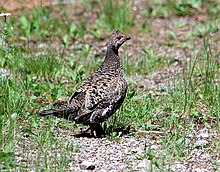Dusky grouse
| Dusky grouse | |
|---|---|

| |
| Male displaying, Yellowstone National Park | |

| |
| Female in New Mexico, USA | |
| Scientific classification | |
| Domain: | Eukaryota |
| Kingdom: | Animalia |
| Phylum: | Chordata |
| Class: | Aves |
| Order: | Galliformes |
| Family: | Phasianidae |
| Genus: | Dendragapus |
| Species: | D. obscurus
|
| Binomial name | |
| Dendragapus obscurus (Say, 1822)
| |

| |
The dusky grouse (Dendragapus obscurus) is a species of forest-dwelling grouse native to the Rocky Mountains in North America.[2][3] It is closely related to the sooty grouse (Dendragapus fuliginosus), and the two were previously considered a single species, the blue grouse.[2][3][4]
Description
Adults have a long square tail, gray at the end. Adult males are mainly dark with a purplish
Males are larger than females, with a male mean body mass of 1.21 kg (2.67 lbs.) compared to a mean 0.91 kg (2.01 lbs.) in females.[5]
Distribution and habitat
The breeding habitat of the dusky grouse is the edges of conifer and mixed forests in mountainous regions of western North America, from southeastern Alaska and Yukon south to New Mexico.[3] Their range is closely associated with that of various conifers. Their nest is a scrape on the ground concealed under a shrub or log.
Taxonomy
The dusky grouse has four recognized subspecies:[6]
- D. o. obscurus (Say, 1822)
- D. o. oreinus (Behle & Selander, 1951)
- D. o. pallidus (Swarth, 1931)
- D. o. richardsonii (Douglas, 1829)
Migration
They are permanent residents but move short distances by foot and short flights to denser forest areas in winter, with the odd habit of moving to higher altitudes in winter.[2]
Diet
Dusky grouse forage mainly for plant matter on the ground, as well as in trees and along branches (in the winter). During the coldest months, they mainly eat
Breeding
Males sing with deep hoots on their territory and make short flapping flights to attract females. Females leave the male's territory after mating.
References
- . Retrieved 12 November 2021.
- ^ ISBN 84-87334-15-6.
- ^ ISBN 0-679-45122-6.
- . Retrieved 2007-09-16.
- ISBN 978-1-4200-6444-5.
- ^ Gill, Frank; Donsker, David; Rasmussen, Pamela, eds. (July 2021). "Pheasants, partridges, francolins". IOC World Bird List Version 11.2. International Ornithologists' Union. Retrieved 13 October 2021.

